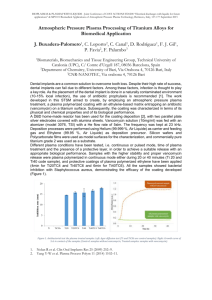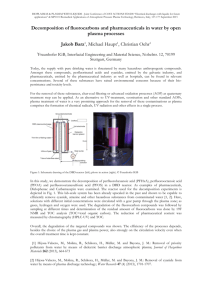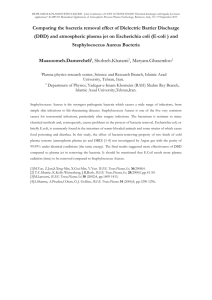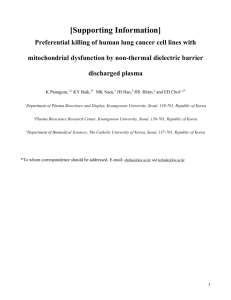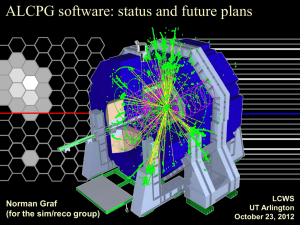STSM Abstract-JOINT-COST-Bertinoro-September
advertisement
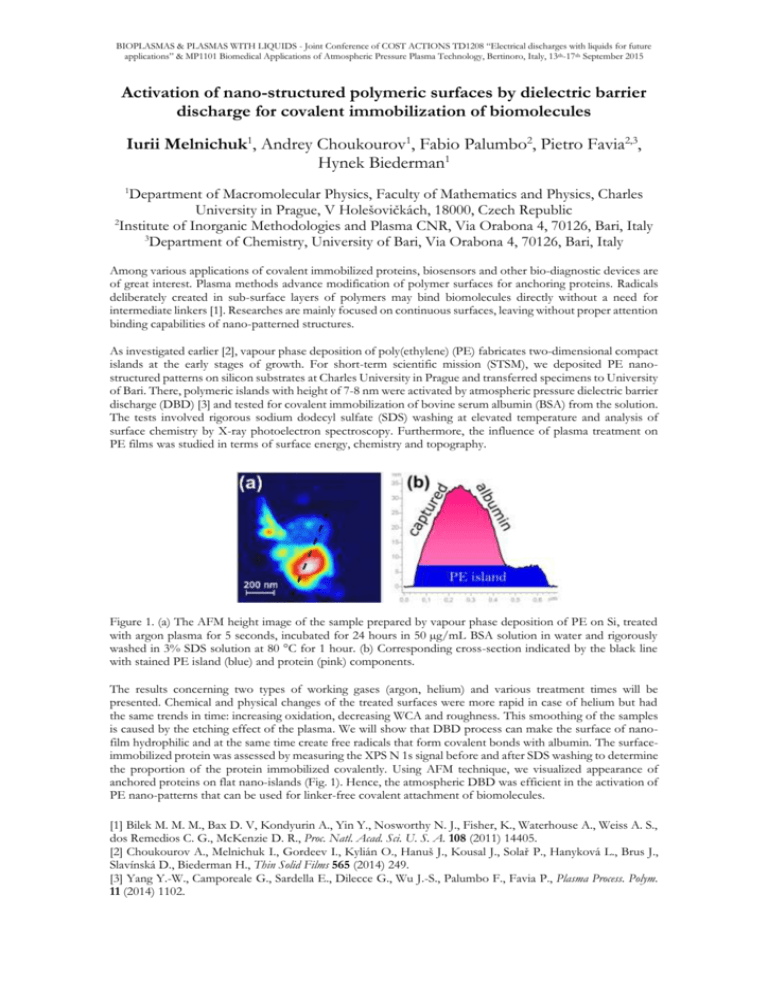
BIOPLASMAS & PLASMAS WITH LIQUIDS - Joint Conference of COST ACTIONS TD1208 “Electrical discharges with liquids for future applications” & MP1101 Biomedical Applications of Atmospheric Pressure Plasma Technology, Bertinoro, Italy, 13th-17th September 2015 Activation of nano-structured polymeric surfaces by dielectric barrier discharge for covalent immobilization of biomolecules Iurii Melnichuk1, Andrey Choukourov1, Fabio Palumbo2, Pietro Favia2,3, Hynek Biederman1 1 Department of Macromolecular Physics, Faculty of Mathematics and Physics, Charles University in Prague, V Holešovičkách, 18000, Czech Republic 2 Institute of Inorganic Methodologies and Plasma CNR, Via Orabona 4, 70126, Bari, Italy 3 Department of Chemistry, University of Bari, Via Orabona 4, 70126, Bari, Italy Among various applications of covalent immobilized proteins, biosensors and other bio-diagnostic devices are of great interest. Plasma methods advance modification of polymer surfaces for anchoring proteins. Radicals deliberately created in sub-surface layers of polymers may bind biomolecules directly without a need for intermediate linkers [1]. Researches are mainly focused on continuous surfaces, leaving without proper attention binding capabilities of nano-patterned structures. As investigated earlier [2], vapour phase deposition of poly(ethylene) (PE) fabricates two-dimensional compact islands at the early stages of growth. For short-term scientific mission (STSM), we deposited PE nanostructured patterns on silicon substrates at Charles University in Prague and transferred specimens to University of Bari. There, polymeric islands with height of 7-8 nm were activated by atmospheric pressure dielectric barrier discharge (DBD) [3] and tested for covalent immobilization of bovine serum albumin (BSA) from the solution. The tests involved rigorous sodium dodecyl sulfate (SDS) washing at elevated temperature and analysis of surface chemistry by X-ray photoelectron spectroscopy. Furthermore, the influence of plasma treatment on PE films was studied in terms of surface energy, chemistry and topography. Figure 1. (a) The AFM height image of the sample prepared by vapour phase deposition of PE on Si, treated with argon plasma for 5 seconds, incubated for 24 hours in 50 µg/mL BSA solution in water and rigorously washed in 3% SDS solution at 80 °C for 1 hour. (b) Corresponding cross-section indicated by the black line with stained PE island (blue) and protein (pink) components. The results concerning two types of working gases (argon, helium) and various treatment times will be presented. Chemical and physical changes of the treated surfaces were more rapid in case of helium but had the same trends in time: increasing oxidation, decreasing WCA and roughness. This smoothing of the samples is caused by the etching effect of the plasma. We will show that DBD process can make the surface of nanofilm hydrophilic and at the same time create free radicals that form covalent bonds with albumin. The surfaceimmobilized protein was assessed by measuring the XPS N 1s signal before and after SDS washing to determine the proportion of the protein immobilized covalently. Using AFM technique, we visualized appearance of anchored proteins on flat nano-islands (Fig. 1). Hence, the atmospheric DBD was efficient in the activation of PE nano-patterns that can be used for linker-free covalent attachment of biomolecules. [1] Bilek M. M. M., Bax D. V, Kondyurin A., Yin Y., Nosworthy N. J., Fisher, K., Waterhouse A., Weiss A. S., dos Remedios C. G., McKenzie D. R., Proc. Natl. Acad. Sci. U. S. A. 108 (2011) 14405. [2] Choukourov A., Melnichuk I., Gordeev I., Kylián O., Hanuš J., Kousal J., Solař P., Hanyková L., Brus J., Slavínská D., Biederman H., Thin Solid Films 565 (2014) 249. [3] Yang Y.-W., Camporeale G., Sardella E., Dilecce G., Wu J.-S., Palumbo F., Favia P., Plasma Process. Polym. 11 (2014) 1102.
